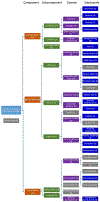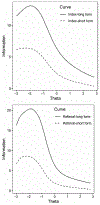Development of a parents' short form survey of their children's oral health
- PMID: 30481390
- PMCID: PMC8191488
- DOI: 10.1111/ipd.12453
Development of a parents' short form survey of their children's oral health
Abstract
Background: Parents play an important role in their children's oral health behaviors, provide oral health access, initiate prevention, and coping strategies for health care.
Aim: This paper develops a short form (SF) to assist parents to evaluate their children's oral health status using Patient-Reported Outcome Measurement Information System (PROMIS) framework that conceptualized health as physical, mental, and social components.
Design: Surveys of parents were conducted at dental clinics in Los Angeles County, together with an on-site clinical examination by dentists to determine clinical outcomes, Children's Oral Health Status Index (COHSI), and referral recommendations (RRs). Graded response models in item response theory were used to create the SF. A toolkit including SF, demographic information, and algorithms was developed to predict the COHSI and RRs.
Results: The final SF questionnaire consists of eight items. The square root mean squared error for the prediction of COHSI is 7.6. The sensitivity and specificity of using SF to predict immediate treatment needs (binary RRs) are 85% and 31%.
Conclusions: The parent SF is an additional component of the oral health evaluation toolkit that can be used for oral health screening, surveillance program, policy planning, and research of school-aged children and adolescents from guardian perspectives.
© 2018 BSPD, IAPD and John Wiley & Sons A/S. Published by John Wiley & Sons Ltd.
Conflict of interest statement
CONFLICT OF INTEREST
The authors declare no conflict of interest.
Figures
References
-
- Okada M, Kawamura M, Kaihara Y, et al. Influence of parents’ oral health behaviour on oral health status of their school children: an exploratory study employing a causal modelling technique. Int J Pediatr Dent. 2002;12(2):101–108. - PubMed
-
- Talekar BS, Rozier RG, Slade GD, Ennett ST. Parental perceptions of their preschool-aged children’s oral health. J Am Dental Assoc. 2005;136(3):364–372. - PubMed
-
- Olak J, Saag M, Honkala S, et al. Children’s dental fear in relation to dental health and parental dental fear. Stomatologija. 2013;15(1):26–31. - PubMed




